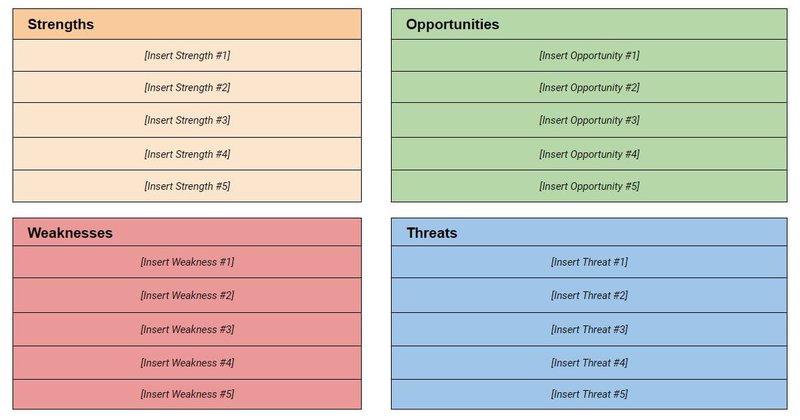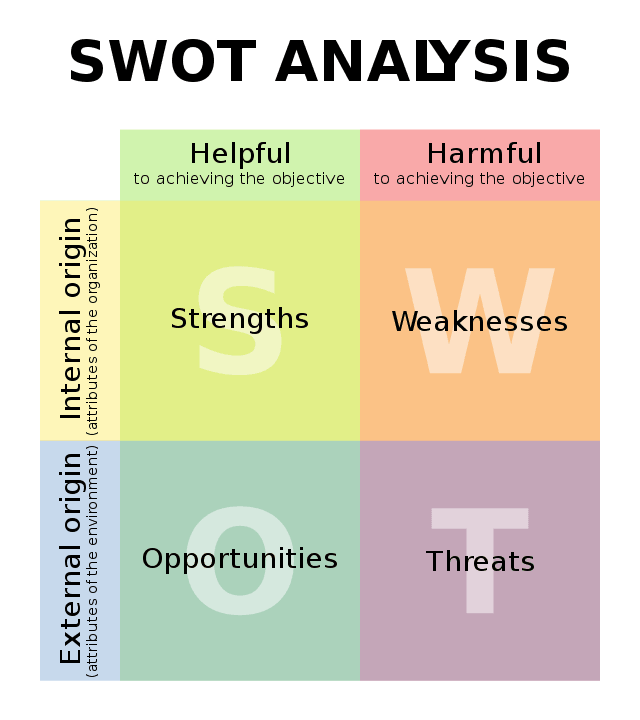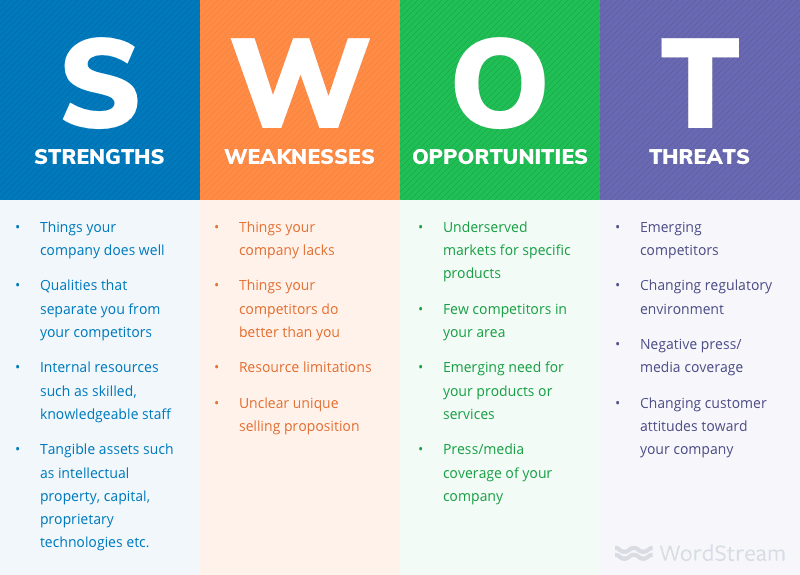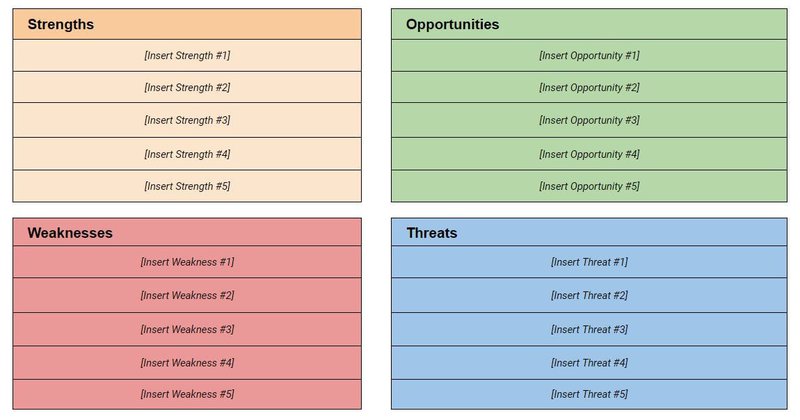How to do a SWOT Analysis The Right Way + [Free Template]
Here's how to do a SWOT Analysis in 5 Easy Steps. Analyze your Strengths, Weaknesses, Opportunities, and Threats. Plust get our Free SWOT Analysis Template.
Updated November 7, 2024
![How to do a SWOT Analysis The Right Way + [Free Template] main image](https://entail.mayple.com/en-assets/mayple/634eafb224053437d14c9270_swotanalysistemplate_1f4242b19e98251e92387497f847801e_2000-1699775582876.png)
Running a marketing strategy without doing a SWOT analysis is like driving a car without GPS. You're definitely going somewhere, but you're probably not going to get to your destination.
I remember I was taking a graduate-level course in marketing strategy and we spent several classes talking about SWOT analysis. And I thought to myself, man, this is so basic, why do we need to cover this?
What I found out is that a thorough SWOT analysis is the foundation of a firm's strategy. It's the first thing that investors ask when they're talking to a new startup and it's the framework companies use to create new products.
In this post, we break down exactly what a SWOT analysis is, how you can use it to grow your business, and provide a really easy marketing template to make it all happen.
Let's dive in.
What is a SWOT analysis?
SWOT analysis is a framework used to identify the internal and external factors that affect your business. It was created in the 1960s by Albert Humphrey of the Stanford Research Institute during a study he conducted to understand why corporate planning consistently failed.
SWOT stands for Strengths, Weaknesses, Opportunities, and Threats.
Strengths are internal factors you have control over, such as your company’s human resources, finances, or expertise. Weaknesses are also internal factors that can be improved upon with time and effort.
Opportunities and threats are external factors. Opportunities can include a new market, consumer demand, or new technology. Threats can be a new competitor or a demand for a new feature that you don't currently have.
SWOT analysis gives businesses insight into where they stand at any given point in time so they can make smart decisions about where to focus their efforts moving forward — whether it's on growing their strengths or overcoming weaknesses — while minimizing threats and capitalizing on opportunities.
The Benefits of doing a SWOT analysis
There are many benefits to a SWOT analysis including:
- It provides you with an overview of your business, allowing you to see its internal strengths and weaknesses as well as any external opportunities or threats.
- It helps you identify your biggest competitors (competitor analysis) and your position in the market (or market share)
- A SWOT analysis can be used to identify new market trends and see where improvements need to be made in order for the company to grow
- It helps companies uncover expansion opportunities by understanding their situation better so they can plan accordingly
- It helps businesses control risks and take advantage of opportunities
- It helps businesses create a marketing plan that sets out their goals and objectives for the future of their company
Components of SWOT Analysis
Strengths
Strengths are the positive qualities of your business that give you an advantage over others. Areas in which you excel, or have a strong reputation, can be listed here.
Strengths are the internal positive attributes that are in your favor, that provide your company with a competitive advantage. They can be tangible or intangible, but they’re the things that you do really well. This could include a certain technology or product feature, intellectual property, a talented team member, or even something more fundamental such as raw materials or a strong cash reserve.
Here are some examples:
- You have a leadership team that is experienced in the industry and has worked together for many years.
- Your company has a reputation for being environmentally friendly and sustainable.
- Your company values its employees, which means you have a low turnover rate and high employee morale.
Weaknesses
Weaknesses are internal disadvantages or drawbacks of your organization. This is typically a lack of experience, resources, or technical expertise. This key component of a SWOT analysis can include weaknesses in relation to other companies in your industry or
For example, if you want to start a business in the food industry and don't have much capital to invest in starting up the business, or if you lack cooking skills, then that would be your weakness.
Opportunities
Opportunities are external factors that can help your business grow in a positive way. They could include:
- Government policy changes that favor your business
- The exit of key players in the market
- An increase in demand due to a change in consumer preferences
Opportunities are also called “market opportunities” or “external opportunities” because they help you find ways to capitalize on market trends and customer needs.
Threats
Threats are external factors that can disrupt your business and can include anything from competitors to changing regulations to economic conditions.
Examples of threats in different industries include:
- A competitor who is offering a similar product at a lower price point (which is why it’s super important to track competitor pricing)
- The introduction of new technology that makes your company's products obsolete.
- An unstable political environment or natural disaster that causes disruption in supply chains, making it difficult for you to fulfill orders on time or at all
Internal vs external factors in a SWOT analysis
Looking at the four components of the SWOT analysis you'll notice that they divide into two main ones - internal factors and external factors. An internal factor is something that your company can control, like a strength or weakness. An external factor is something that's outside of your company's control, like an opportunity or threat.
And that's what really makes the framework so powerful for brands. Marketing teams have biases and tend to ignore one or more quadrants (oops) and that's why you should do this analysis to make sure you have everything you need to create a really good strategic plan and make better business decisions.
How to do a SWOT analysis
Now that you know what goes into a SWOT analysis let's talk about how to actually do one. Here are five simple steps to help you use the framework.
Step 1 - Determine your goal
Before you start the actual SWOT analysis, it's important to know the purpose of your analysis and what you hope to achieve at the end of the process. That way, you can make sure that every step of the process is relevant and helpful.
Here are some questions to ask yourself:
- Are you launching a new business and need to create a business plan?
- Are you trying to improve your existing business strategies?
- Do you need to pivot and better align your product with your target audience?
- Are you looking to expand into a new geography and need to determine what potential threats there may be or what future operations will look like?
Now that you have your goal in mind, it's time to gather some data.
Step 2 - Gather your data
To create your SWOT analysis, you will need data and information about your business and the market. You can get this by interviewing employees, surveying customers, or examining existing data and reports.
The best way to work through the framework is to have a brainstorming session with all of the relevant team members. You should grab someone from marketing, product, R&D, operations, and customer service.
Step 3 - Compile ideas
Once you have everyone in the room it's time to fill out the four quadrants. You should begin to list ideas for each category, as many as possible.
Here are a few key analysis questions to answer:
Strengths
- What is our competitive advantage?
- What resources do we have?
- Which of our products is performing well?
Weaknesses
- What resources do we lack?
- Where can we improve?
- Which products are underperforming?
Opportunities
- What new trends are we seeing in the marketplace?
- Can we expand our operations?
- What new market segments can we test?
- What potential opportunities exist for the company
Threats
- What are competitors doing?
- What regulations are changing?
- How are consumer trends changing?
- What are the various external negative factors that could impact our business performance in the future?
Step 4 - Refine findings
Now it's time to clean up your ideas. Take your list for each category and select the most important factors. The most powerful strengths and weaknesses, the most promising opportunities, and the most troubling threats. You may need to debate some of these until you finalize your analysis.
Step 5 - Develop the strategy
The next step is to develop a strategy based on the information you have gathered from your SWOT analysis. This involves deciding which opportunities will be prioritized and how you will address the threats.
You should create the main action plan with a list of action items for each department. And you should also create a contingency plan in case something goes wrong.
Get our SWOT Analysis Template
Use our SWOT analysis template to create your own analysis or help revise an existing analysis and make improvements. It's a really easy customizable Google Sheet template that you can duplicate, and make your own.









![Competitor Analysis: How to Spy on Your Competition in {year} [Free Template]](https://entail.mayple.com/en-assets/mayple/fit-in/280x280/635592ede551c61cc6cefd0a_austindistelwD1LRb9OeEounsplash11_ae2a6644f2663d2f32cd0295822bfbe3_2000-1699775590539.jpg)